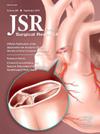Predictors and Trends of Hemorrhage After Bariatric Surgery Using Two Large National Datasets: A Retrospective Observational Study
IF 1.8
3区 医学
Q2 SURGERY
引用次数: 0
Abstract
Introduction
The National Inpatient Sample (NIS) is a comprehensive representative database for inpatient hospitalizations; the Metabolic and Bariatric Surgery Accreditation and Quality Improvement Program (MBSAQIP) database aggregates surgical outcomes from nationally accredited bariatric surgical programs. There has been no comparison of postoperative hemorrhage rates nor a comparison of predictors of hemorrhage between the two databases. The aim of this study was to compare trends and predictors of significant hemorrhage after bariatric surgery using two national databases.
Methods
The core NIS files of the Healthcare Cost and Utilization Project and the MBSAQIP Participant Use Data Files from 2016 to 2021 were concatenated, and vertical sleeve gastrectomy and Roux-en-Y gastric bypass procedures were included. Trends in a 3-d postoperative hemorrhage requiring blood transfusion were derived from both datasets. Demographic, comorbidity, and other health factors were analyzed to construct multivariable logistic regression models.
Results
Briefly, 204,866 and 1,029,979 patients were identified in the NIS and MBSAQIP, respectively, and 3-d inpatient blood transfusion rates were 0.48% and 0.64%. Anticoagulants, Black race, diabetes, and increased age were associated with higher risk of a blood transfusion in both datasets. Vertical sleeve gastrectomy had a lower transfusion risk than Roux-en-Y gastric bypass (NIS: odds ratio: 0.62; 95% confidence interval [0.53, 0.71], P < 0.05; MBSAQIP: odds ratio: 0.52 [0.49, 0.55], P < 0.05). The NIS reported consistently lower annual 3-d transfusion rates relative to the MBSAQIP.
Conclusions
Health care professionals should be aware of the associated risk factors for blood transfusion after bariatric surgery. Most blood transfusions occurred during the initial hospitalization.
求助全文
约1分钟内获得全文
求助全文
来源期刊
CiteScore
3.90
自引率
4.50%
发文量
627
审稿时长
138 days
期刊介绍:
The Journal of Surgical Research: Clinical and Laboratory Investigation publishes original articles concerned with clinical and laboratory investigations relevant to surgical practice and teaching. The journal emphasizes reports of clinical investigations or fundamental research bearing directly on surgical management that will be of general interest to a broad range of surgeons and surgical researchers. The articles presented need not have been the products of surgeons or of surgical laboratories.
The Journal of Surgical Research also features review articles and special articles relating to educational, research, or social issues of interest to the academic surgical community.

 求助内容:
求助内容: 应助结果提醒方式:
应助结果提醒方式:


